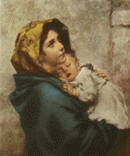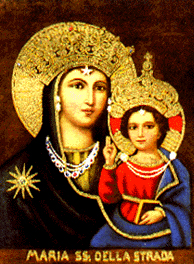Madonna of the Street
Madonna of the Street
– Answered by Father Johann Roten, S.M.
Q: Do you have any information about a shrine or devotion to Mary as the Madonna of the Street?
A: Roberto Ferruzzi, born in 1854 to a well-to-do widow of Sebenico, a small Italian town on the Dalmatian coast, was an educated man who studied law and art in Venice. His love for painting triumphed and he devoted his whole life to art. Before he was thirty years old he exhibited in Turin and Venice. His reputation as an artist was solidly established when in 1897 La Madonnina was first exhibited in Venice. Very little else is known about Roberto Ferruzzi. It is said that he lived in a palace but was nevertheless beloved as a neighbor and artist. He died in 1934.

The artist called his painting Little Madonna because he took a peasant girl from the region of Padua to pose for this picture. According to credible sources, the girl was one Angelina Cian who eventually emigrated to San Francisco with her husband Antonio Boro where they raised a family of ten children. When Ferruzzi first spotted the girl, she was about eleven years old and caring for her baby brother. The artist decided to paint a portrait of the two. He never intended the painting to be one of the Virgin Mary. But since the girl looked like a little Madonna, he called the painting Madonnina. The Little Madonna eventually gained world fame and came to be known as Madonna della Strada (Madonna of the Street). This new name reflects the spirit and flavor of the art work. The focal point is the girl's face with its pleading and expressive countenance. It is wrapped in a gold colored headdress, the only warm color of the whole painting. The blues and greys and dirty whites of mother's and child's dress and of the whole backdrop suggest hardship, toil and poverty. There is a contrast between Mother and child: while the child is safely cuddled and asleep in the arms of his mother, Our Lady appears to be standing on somebody's doorstep begging for shelter and food. Many people see in this picture a direct and personal challenge, expressed in Mary's look, to open our hearts to her Son. This original painting seems to be lost at present. The last owner appears to have been a Mr. John G. A. Leishman who died in France in 1924. Over the years many correspondents enquired on the whereabouts of this popular painting. Among them were those who thought they owned the original, alas, without having serious proof. So far, the original painting has not been located. However, a recent article in St. Anthony's Messenger elucidates part of the mystery surrounding this painting. The identity of the girl and baby depicted by Feruzzi seems now to be known thanks to the tireless research conducted by an American nun into the Italian past of her family. You may find more details about the whole interesting story in Sister Carol Anne O'Marie's "Her Mother was a Madonna" pp. 58-61 in the May, 1986 issue of Catholic Digest.
There is a famous picture of the Madonna della Strada at the Church of the Gesu in Rome. Also named "Our Lady of the Wayside," this devotional image dates from the fourteenth century and was originally kept in the Church of the Astalli. There are also various Houses of Formation and local sanctuaries throughout Western Europe known by the name of Our Lady of the Street. It is sometimes used in representations of Our Lady intended to symbolize poverty, the homeless, etc.
All About Mary includes a variety of content, much of which reflects the expertise, interpretations and opinions of the individual authors and not necessarily of the Marian Library or the University of Dayton. Please share feedback or suggestions with marianlibrary@udayton.edu.

